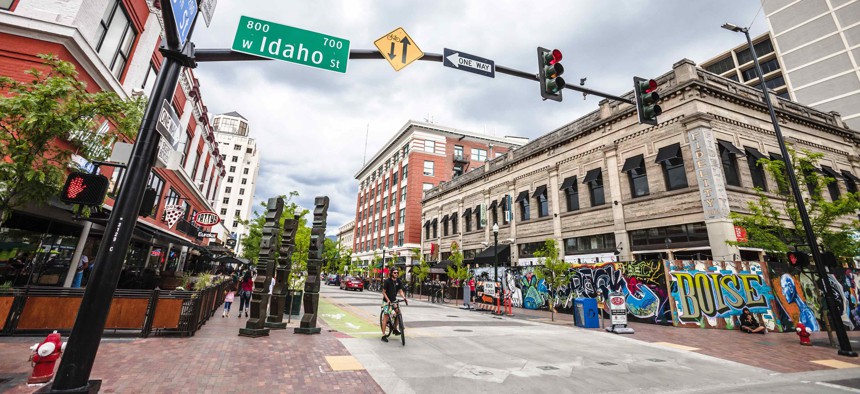Rental Prices are Booming in Mid-Sized Cities

A view of a downtown street in Boise, Idaho, where rental costs are on the rise. iStock.com/peeterv
New estimates show how places like Boise, Idaho and Spokane, Washington have seen housing rents rise sharply during the pandemic. And the trend isn’t easing up.
Residential rent prices in mid-sized U.S. cities, particularly in the West, are surging even as major metro areas come back to life and people move on from remote work arrangements and return to offices.
That’s according to new estimates from the rental listing website Apartment List. Those figures also show that rent prices are rebounding in expensive coastal cities where they dropped sharply during the coronavirus pandemic. But prices in those places are still down. The report points out that in the mid-sized cities with booming rents, the past year didn’t spark the trend so much as add fuel to it.
“Many of these markets had been heating up prior to the pandemic,” the report says. “The pandemic and remote work spurred demand for the space and affordability that these cities offered, and in response, rent prices grew even as the surrounding economy struggled.”
It’s interesting data to consider for those wondering how quickly major cities will bounce back and to what extent the rise of telework, along with other factors that led people to move in the past year, will contribute to lasting growth in mid-sized cities. It also raises questions about the future of affordable housing in smaller markets that are becoming magnets for newcomers.
The report says pandemic-era declines in Apartment List’s national index of rent prices have now been erased and the report declares that “pandemic pricing is officially over.” For May, the index shows a 2.3% month-over-month gain in rental prices nationwide, the largest single-month increase Apartment List has recorded with its estimates, which date back to 2017.
Boise, Idaho is one of the cities that’s seen rent balloon the most since the pandemic began. The report says that, compared to March 2020, rents are up in Boise by 31% and that they jumped 6.6% last month alone. The report calls the monthly increase “staggering.”
In Spokane, Washington, which is about 300 miles east of Seattle near the Idaho border, rent was up 22% last month compared to last March. In Fresno, California the increase was 17%. Virginia Beach, Virginia; Reno, Nevada; and Mesa, Glendale and Gilbert, Arizona (cities on the outskirts of Phoenix) all saw 15%-16% increases.
Meanwhile, nine of the 10 cities with the steepest declines in the past year have now seen growth in rental prices for four straight months, according to the analysis. But in some of those places, prices are still well below where they were when the virus outbreak began.
In San Francisco, rents were down 17% in May compared to March 2020, the estimates show. Rents had sunk there by around 25% to 30% in the December to February timeframe.
Other major cities are seeing similar trends. In May, compared to last March, rents were down 12% in New York, 11% in Seattle, 9% in Washington, D.C., 6% in Boston and 5% in Minneapolis. Each of these cities saw prices rise by varying degrees since the winter months.
Highlighting San Francisco and Boise as an example, the report notes that the price gap between rent in pricey coastal cities and mid-sized markets, while still sizable, is narrowing. Last March, median rent for a two bedroom in San Francisco was $3,146. In Boise it was $929. Those prices have shifted now to $2,610 in and $1,229 respectively.
“Even as rents in San Francisco have rebounded in recent months, Boise has continued to grow even faster,” the report says. It adds: “Many of the mid-sized markets that have seen rents grow rapidly through the pandemic are showing that there’s still steam left in the current boom.” A full copy of the analysis can be found here.
Bill Lucia is a senior editor for Route Fifty and is based in Olympia, Washington.
NEXT STORY: State and Local Officials Push Back Against Calls to Redirect Federal Aid






